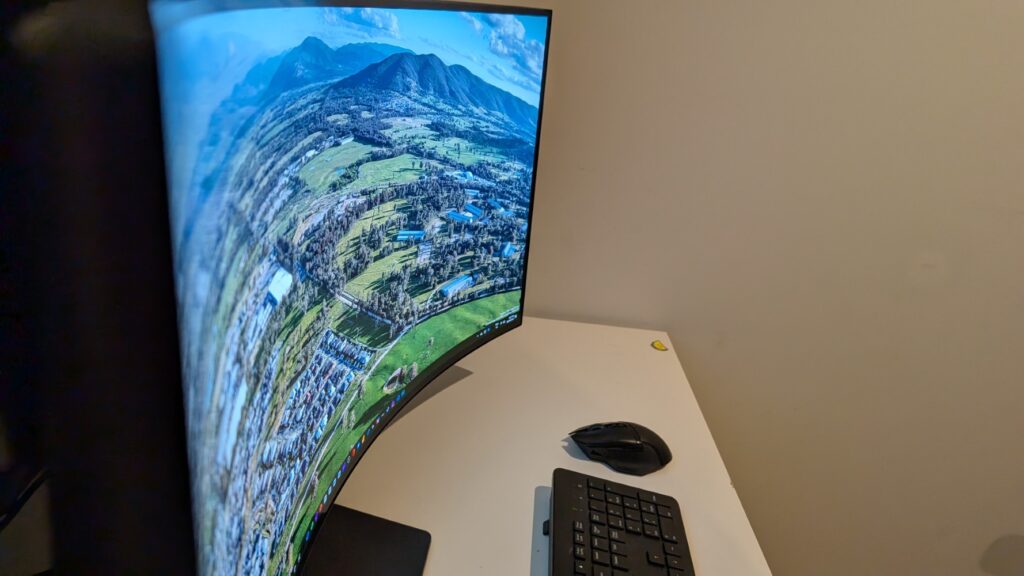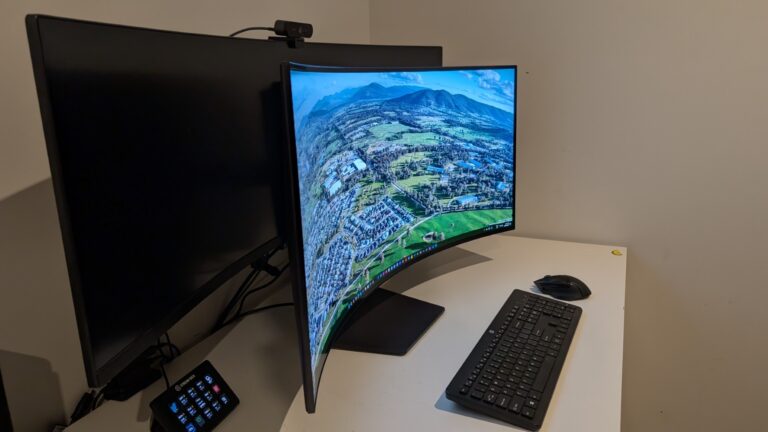Computer monitors have come a long way in recent years and what’s available now is nothing short of amazing. I’m someone who moved to a single ultrawide monitor in favour of multi-monitor setups some years ago, so when I was offered this Ultragear to review, I wasn’t sure I was going to be shocked, but I was wrong.
Coming from a 49″ ultrawide monitor with a 1800R curvature and a pixel arrangement of 5120×1440, I expected a fairly similar experience, understanding most of the benefits. Having now spent time with the LG Ultragear, its clear that it offers a whole new experience and in this review we take an in depth look at the display, and will let you know if you should consider it for your next monitor.

Design
The monitor offers an aggressive 800R curvature and despite reading that on the spec sheet, there is still nothing that prepares you for how confronting the monitor is when you sit in front of it, an arms-length away.
As you sit in front of it, the display consumes your entire view, most noticeably the curvature of the screen completely envelopes your view, enhanced by a greater vertical height than I’m used to.
The screen features a 3440 x 1440 resolution in a 21:9 aspect ratio and runs at up to 240Hz. While you’ll barely notice that speed in desktop apps, you absolutely will in video games that support it, assuming your GPU can power it.
When displays started going curved, the TV industry jumped on board and attempted to add curves, but that was the wrong application as TVs are viewed by multiple people in the home. A desktop monitor is the perfect application for a curved display as the experience is a solo one, so surrounding the user with pixels is welcome.
The curve of the display looks aesthetically pleasing but it’s the in-game immersion that is really the experience you’ll buy this monitor for, wrapping the game environment around your field of view.
The design of the display is sleek, with a virtually borderless screen that floats above its stand, one that’s adjustable in height, tilt, and swivel, providing ergonomic comfort for long gaming sessions.


Performance
If you’ve only played on 60Hz displays, then playing at 240Hz will be a night and day experience. If you’re upgrading from a 120 or 144Hz display, then 240Hz will be a significant step you’ll certainly notice, so don’t be afraid there won’t be enough of a difference to make it worth it.
The 240Hz refresh rate occurs at incredibly low response time of 0.03ms. This makes it an excellent choice for fast-paced gaming, where every millisecond counts, just make sure you have the graphics processing to keep up with it.
Personally I use the NVIDIA RTX3080 and was glad to see the NVIDIA G-SYNC prompt appear when I connected the display (by DisplayPort). For those who play on the AMD side, it also supports FreeSync Premium Pro, both display technologies reduce screen tearing and stuttering for a smoother gameplay experience.
Having spent time in both multitasking productivity apps and fullscreen gaming, the monitor works great for both applications, but its the gaming where this display really shines.
The who objective of games is to immerse you in the experience, to trick your brain into thinking you’re in the world, particularly when you’re playing a FPS.
I went searching for games to play because the monitor was such a breathtakingly great experience. From Call of Duty, Cyberpunk 2077, to Only Up! and even games like Liftoff (drone simulator) and racing titles like JDM: Rise of the Scorpion and Forza Motorsport, this monitor eats up anything you feed it.
Features
Something I was impressed by is the display’s on-screen menu, something that is often an after thought despite it being the primary way you configure the display.
At the back of the screen in the lower-center, you’ll find a single button joystick, just press it to launch the UltraGear branded UI which slickly animates on top of your screen. On the left, you’ll have access to a feature called ‘Hexagon lighting’ which is the rear-facing RGB lights that illuminate the wall behind your display.
If you press the button on the settings, you’ll be gain access to Game Adjust, Picture Adjust, Sound, Input and General menu options. The monitor features some Picture in Picture display modes, one of which you may enjoy is a side-by-side, which could allow you to have productivity on the left, and fun on the right (i.e. something like the Switch via HDMI).
Gamers have praised the performance, particularly highlighting the immersive experience due to the curve and the quality of the OLED display. The monitor handles HDR content well, with users noting peak brightness in HDR mode reaching impressive levels, something you’ll want to hunt for the perfect game to experience properly.
When it comes to inputs, the display includes HDMI 2.1 ports, which are crucial for next-gen console gaming at high refresh rates, alongside a DisplayPort 1.4. However one miss is a lack of USB-C connectivity, which could be a downside for those looking to connect modern devices with a single cable for video, data, and power.


Issues and Opportunities
While there’s a lot to love, not everything is perfect. The following items are suggestions for improvement in future editions of the device.
If you’re someone who watches videos on your computer display, then you should appreciate that you’ll see some black bars around your context, something unavoidable with the difference between 16:9 and 21:9 aspect ratios. When it comes to issues, this is about as small as it gets.
Regarding its retail price, this is positioned as a premium display so that comes with a premium price. Naturally, we’d all love to see the price tag be more affordable, with the absence of integrated speakers and some connectivity options potential reasons to make some buyers hesitate.


Price and Availability
The LG UltraGear 39″ 240Hz OLED Gaming Monitor is available now. Obviously with the size, specs and performance of this display, you’d expect to pay a premium price. This monitor will set you back A$1,899 from places like MWave.com.au and PC Case Gear.
If that price feels high, it is, but reflects the experience that you get from it.
If you are like me and really enjoy the single display that skips on the middle bezels of a dual-display setup, then you will need to pay a premium for the seamless, uninterrupted views. If you want a large, immersive display that also performs at these speeds, then that will come at a premium.
The good news is, if you can afford it, the cost is definitely worth the price of admission.


Overall
The LG 39GS95QE-B is a top-tier gaming monitor that excels in delivering a high-refresh-rate, color-accurate, and deeply immersive gaming experience. Its OLED technology sets it apart in the gaming arena, although potential buyers should weigh its benefits against its price and suitability for non-gaming tasks.
For pure gaming immersion, this monitor is really hard to beat, it feels personal, it envelops you which makes it incredibly easy to forget there’s a world outside it.
With the display quality and performance, there’s really you can throw at it that it can’t handle and I love that about a premium display, regardless of your use-case for it, its there, ready and waiting to assist.
Overall the monitor is stunning to live with daily and if your objective is to replace two display with a single ultrawide, without making compromises, then this monitor should be right at the top of your list. The price will be a challenge for some to overcome, but to that I’d say, its important to remember that monitors typically last you multiple PCs, sometimes as much as 10 years, so if you need to get creative with the accounting, break it down to a per year cost and that’ll make you feel a lot better about the up-front cost which is definitely worth the price of admission.
